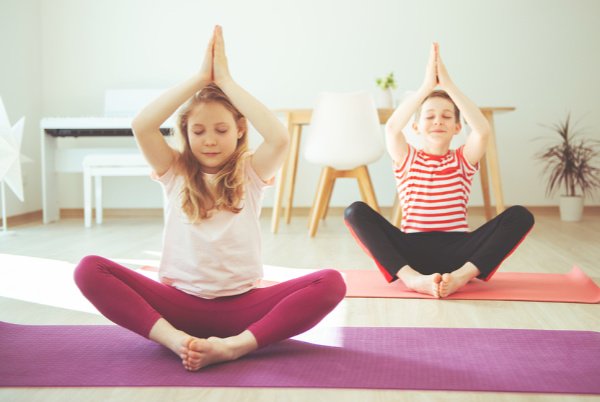
If your child struggles to regulate their emotions at home, we’re sharing 10 calming strategies for kids to help. Inspired by the Zones of Regulation and Social Thinking curriculums, these tips help prevent emotional outbursts and equip children with the tools they need to calm down when they are triggered. Perfect for toddlers, kids in elementary and middle school, and even tweens and teens, these ideas are easy to implement and extremely effective in helping little ones learn the art of self-control.
10 Calming Strategies for Kids
1. MINDFUL BREATHING
Mindful breathing is one of my favorite calming strategies for kids as it’s so effective and can be used anywhere. When a child is experiencing feelings of stress or anxiety, his or her breathing pattern will change. He or she will start to take short, fast, and shallow breaths, making it harder to feel in control of their emotions. Mindful breathing – taking in a slow breath through the nose, holding the breath for a few seconds, then exhaling slowly through the mouth – will help your child focus on something other than his or her thoughts and worries, and once their breathing has slowed, they will feel more calm.
CLICK HERE for 10 mindful breathing exercises for kids!
2. COUNTING OR RECITING
While mindful breathing is very effective in helping kids calm down, it does take practice and can be a little harder for younger kids to grasp. Another option is to ask your child to count or recite something quietly when their emotions are high. You can make this as easy (count from 1 to 20) or complex (recite the alphabet backwards) depending on the age of your child and how big of a distraction they need.
3. CREATE A CALM DOWN CORNER WITH CALMING TOOLS
Having a designated area within your home where your child can take a break when they feel overwhelmed is another great way to help keep their emotions in check. This may require a bit of prompting from you at first (‘I notice you’re feeling a little frustrated. Why don’t you go to the Calm Down Corner for a few minutes?’), but teaching your child how to recognize their emotions and equipping them with strategies to calm down before things get out of hand is extremely valuable. Make sure your Calm Down Corner has calming tools handy. Fidget toys, squeeze balls, and chewing gum are all great ideas that can help reduce feelings of stress and a anxiety and restore a sense of calm.
4. ASSESS THE SIZE OF THE PROBLEM
Another one of my favorite calming strategies for kids is called ‘size of the problem’, and it’s an effective tool to help kids pause and consider if their reactions match the size of problem they are encountering. The ability to classify problems as small, medium, or big takes practice, but the more you review the concept together, the easier it will be for your child to evaluate the challenges he or she faces and consider if he or she is reacting appropriately. Teachers Pay Teachers has an excellent package of size of the problem activities, which you can find HERE.
5. USE A VOICE THERMOMETER
Does your child have a tendency to talk VERY LOUDLY when faced with a problem, or when something unexpected happens? Many children struggle with this, and a voice thermometer can help teach them what voice level is allowed in different situations in and around your home. Teachers Pay Teachers has a lot of different voice thermometers you can download for free (I love THIS ONE!), but it can be really helpful to create your own so you can demonstrate what each level sounds like and identify specific instances each one can be used in your home. Make sure to hang your voice thermometer somewhere visible so you can refer to it often, and give prompts when needed (example: ‘your voice is a level 5 right now, but since we’re indoors, it needs to be a level 3’).
6. USE VISUAL SCHEDULES
Transitions from preferred activities (playing) to things children don’t enjoy as much (homework) often cause kids to become upset. If this sounds like your child, another helpful calming strategy for kids is to create a visual schedule so they have a visual representation of what their day will look like. Visual schedules empower children to move from one activity to the next without prompting, which lessens the chance they will be caught off guard and react poorly. There are tons of pocket visual schedules with pre-printed activities available for purchase on Amazon, but I prefer to make our own using a blank chalkboard and chalkboard markers as it allows for greater personalization.
7. DO A SENSORY CHECK-IN
Another one of my favorite calming strategies for kids is to do a sensory check-in. When your child is feeling overwhelmed, ask him or her to sit in a quiet place and encourage him or her to use each of their 5 senses (sight, sound, smell, touch, and taste) to identify with their surroundings. What does your child see? Hear? Smell? It may seem a bit silly at first, and if your child feels that way, that’s totally okay! The point is to focus on the sensory input he or she is receiving from the world around them instead of the invasive, anxious thoughts he or she is feeling. And when those big emotions do threaten to take over, remind your child to dismiss them and imagine them floating away.
8. PRACTICE YOGA
Yoga for stress isn’t anything new. Some of the benefits of yoga include mental wellness, relaxation, improved respiration, and a lowered heart rate, so it’s no surprise that many parents with children who struggle to regulate their emotions are turning to yoga for relief. There are tons of yoga sequences for kids you can stream for free on YouTube, but if you’re looking for something you can use offline, we love our Yoga Pretzels kit. It has 50 fun yoga activities the whole family can enjoy together.
9. GET ACTIVE!
A list of calming activities for kids wouldn’t be complete without ideas to get your kids up and moving. Whether it’s running around in the backyard, throwing an impromptu dance party in your kitchen, bouncing a balloon back and forth to each other, or doing a few yoga poses, providing your little one regular brain breaks will result in improved attention and focus, increased retention, improved emotional regulation, reduced behavioral problems, improved gross motor skills, increased motivation, increased inclusion and cooperation, etc. CLICK HERE for some of our favorite brain breaks for kids!
10. JOURNALING
Journaling is often considered an adult thing to do, but kids of all ages can benefit from journal writing, and it’s another one of my favorite calming activities for kids. Learning how to write our feelings out on paper can make a big difference in all of our lives, and teaching kids how to express themselves freely and work through their problems through their writing can be a very valuable life lesson. Guided journals offer an easy way to get kids used to the idea of journaling, and there are tons of different themes and ideas to choose from. CLICK HERE for a list of our favorite journals for kids as well as 30 creative writing prompts.
If you’re looking for calming strategies for kids, I hope the tips and ideas in this post prove useful to you!













